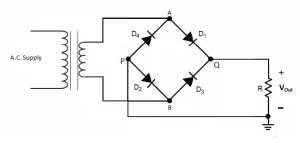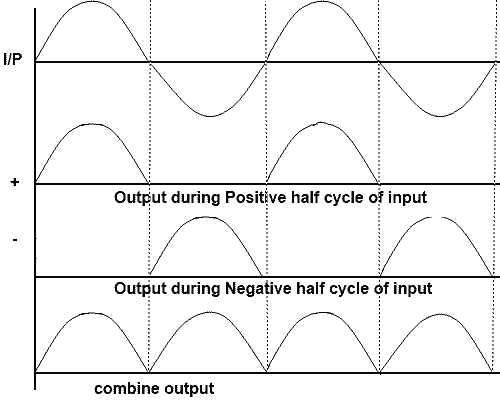What is Bridge Rectifier? Circuit Diagram, Working
Introduction to Bridge Rectifier
Before we get into the core of working a bridge rectifier, let us understand what a rectifier is. A rectifier is an electrical circuit that turns an alternating current voltage input into a direct current voltage at the output terminal. In regular parlance, AC voltage is converted into DC voltage by a rectifier. The rectified output voltage is the name given to this output. Rectifiers are primarily used in power supplies, supplying DC voltage to electronic equipment.
Electronic circuits primarily need rectifiers to power electronic components, whereas DC powering happens from the available AC mains supply. Of the rectifiers, bridge rectifiers are known to be the most effective circuits. They fall under the full-wave rectifier category. In the ensuing sections, let us learn more about the working of bridge rectifiers. Besides, the bridge rectifier circuit diagram is also made available for better understanding through an illustration. The article also clearly covers the characteristics of the full-wave bridge rectifier.
So, rectifiers are primarily classified into two categories, based on their operation-
- Half Wave Rectifiers
- Full-Wave Rectifiers
Full-wave rectifiers are more effective than half-wave rectifiers in increasing the efficiency of the rectification. Full-wave rectifiers generate an output voltage by using both positive and negative half cycles of the input voltage.
Full-wave rectifiers are in turn classified into two types:
- Bridge full-wave Rectifier
- Centre tap full-wave rectifier
Let us know more about full-wave bridge rectifiers before we attempt to get deeper into learning about bridge rectifiers.
A full wave rectifier is a rectifier that transforms both halves of each alternating wave cycle (alternating current) into a pulsing DC (direct current) signal.
Full-wave rectifiers are used for a smoother and more consistent supply of power. Full-wave rectifiers are used to convert a whole cycle of alternating current voltage (AC) to direct current voltage (DC).
The differentiation between these two types of full-wave rectifiers goes a long way in understanding effectively the full-wave rectifier working
In a center-tapped full-wave rectifier, the system is made up of a center-tapped transformer, two diodes, and a resistive load. Whereas, under a full-wave bridge rectifier, the architecture features four diodes or more, and the resistive load. The diodes are named A, B, C and D, and form a bridge circuit.
What is a Bridge Rectifier?
A bridge rectifier is a full-wave rectifier that uses four diodes to create a close-loop bridge. The diodes operate in pairs during each positive and negative half cycle, resulting in no power waste.
A bridge rectifier does not require a center tap over the transformer’s secondary winding. The input is sent through a transformer to the diode bridge’s diagonal. Unlike the center tap rectifier, which consumes 50% of the transformer, the transformer in this circuit is constantly busy since it delivers power during both cycles of input AC.
Bridge Rectifier Circuit Diagram

Bridge Rectifier Waveform

Working on Bridge Rectifier
Typically, a bridge rectifier works as follows:
As soon as an AC signal is sent through the bridge rectifier, terminal A turns positive during the positive half cycle, while terminal B changes to negative. Thus, two diodes, D1 and D3 turn into forward bias, while the other two, D2 and D4 operate in reverse bias.
In the case of a negative half-cycle, terminal B transforms into a positive one while terminal A is now negative. In this case, the diodes, D2 and D4 change to forward bias, whereas the diodes, D1 and D3 are now reverse biased.
Thus, a bridge rectifier enables the flow of the electric current during positive as well as negative half cycles of the input AC signal.
Bridge Rectifier Formulae and Characteristics of Bridge Rectifier
Let us understand the characteristics of a bridge rectifier based on the following aspects:
Ripple Factor
The ripple factor is a factor that measures the smoothness of the output DC signal. The output DC with more occasional ripples is referred to as a smooth DC signal, whereas if the output has more ripples, it is a high-pulsating DC signal.
The ripple factor mathematically is defined as the ratio of ripple voltage to pure DC voltage.
A bridge rectifier’s ripple factor is given by
\(\gamma = \sqrt{ (\frac{ V_{rms} }{ V_{dc} }) ^{2}-1}\)
The ripple factor for bridge rectifiers is 0.48.
Peak Inverse Voltage
A peak inverse voltage is the greatest voltage that a diode can endure when biased in reverse. The diodes D1 and D3 are conducted during the positive half cycle, whereas D2 and D4 are not. Similarly, during the negative half cycle, diodes D2 and D4 current whereas diodes D1 and D3 do not.
Efficiency
The efficiency of a rectifier influences how well it converts Alternating Current (AC) into Direct Current (DC). A bridge rectifier’s highest efficiency is 81.2%.
\(\eta = \frac{DC Output Power}{AC OutputPower}\)
Pros and Cons of Bridge Rectifier
Advantages of Full Wave Bridge Rectifier
- The efficiency of a bridge rectifier is greater than that of a half-wave rectifier. The rectifier efficiency of the bridge rectifier and the center-tapped full-wave rectifier, on the other hand, is the same.
- The bridge rectifier’s DC output signal is smoother than the DC output signal of a half-wave rectifier.
- A half-wave rectifier uses just half of the incoming AC signal and blocks the other half. A half-wave rectifier wastes half of the input signal. A bridge rectifier lets electricity flow through both the positive and negative halves. As a result, the output DC signal is almost equivalent to the input AC signal.
Disadvantages of Bridge Rectifier
- A bridge rectifier’s circuit is more complicated than that of a half-wave rectifier or a center-tapped full-wave rectifier. Bridge rectifiers require four diodes, whereas half-wave and center-tapped full-wave rectifiers need just two.
- As more diodes are utilized, more power is lost. Only one diode is conducted during each half cycle of a center-tapped full-wave rectifier. With a bridge rectifier, on the other hand, two diodes linked in series conduct throughout each half cycle. As a result, the voltage drop is larger with a bridge rectifier.
Final Notes
Tutoroot offers one on one online tuition classes to help you learn more about Bridge Rectifier. Our expert faculty are IITs and from coveted Universities who can help you in your learning journey. Enroll in our Physics online tuition for the best subject knowledge and try with a FREE DEMO Session
FAQ’s
What is the ripple factor of a bridge rectifier?
0.48
What is the RMS value of the Bridge Rectifier?
RMS Voltage = \(V_{rms}= \frac{ V_{m} }{ \sqrt{2} }\)
How does a bridge rectifier work?
When an AC is passed through the full wave bridge rectifier, terminal A becomes positive in the positive half cycle, and terminal B becomes negative in the negative half cycle. As a result, diodes D1 and D3 become forward-biased, whereas diodes D2 and D4 become reverse-biased.
During the negative half-cycle, the voltage at terminal B becomes positive while the voltage at terminal A becomes negative. This leads diodes D2 and D4 to be forward-biased while diodes D1 and D3 remain reverse-biased. As a result, a bridge rectifier allows electric current to flow during both the positive and negative half cycles of the input AC.
Does the bridge rectifier convert AC to DC?
Yes, a bridge rectifier is primarily used to convert AC to DC
Why bridge rectifier is commonly used?
As explained, bridge rectifier is primarily used to convert AC to DC
